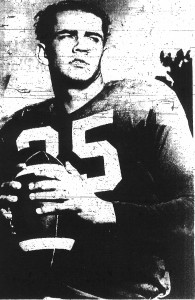Ramona High, in business since 1894 but sans football until 1938, was emerging.
Nestled at 2,200 feet between Mount Woodson and Iron Mountain in San Diego’s East County, the Bulldogs had quietly plugged along in relative mediocrity for 15 years, save for the 6-1 season of Charlie Snell’s 1940 squad.
Ramona suddenly posted a 7-0 record under new coach Glenn Forsythe this season, steamrollering through a variety of competition that included teams from the Southern Prep League and earning a name among Southland small schools.
The Bulldogs were unscored upon until the final game, when they posted a 26-13 victory over a first-year Mission Bay varsity that had played a mostly junior varsity schedule.
Forsythe was a quiet Midwesterner who didn’t raise his voice.
“He was one of the finest men and finest coaches I have known,” said David Farmer, a 1956 graduate who went on to a long and distinguished career in journalism.
WHAT DID YOU SAY?
Forsythe was “so modest and soft spoken that you had to strain to hear him, whether on the field, in the classroom, or in a school assembly,” Farmer remembered.

The Bulldogs heard their coach.
Among victories were routs of 51-0, 47-0, and 45-0 over league rivals Brown Military, Army-Navy, and Mountain Empire, respectively.
Statistics were missing from two early-season wins, 13-0 over San Juan Capistrano and 6-0 over Imperial, so the exploits of Ronnie Blakeley and Ernie Trumper are only partially known.
1-2 TOUCHDOWN PUNCH
Blakeley was at least the second highest scorer in the County with 12 touchdowns and 72 points in five games, including 6 touchdowns against Brown Military.
Trumper followed Blakeley with 10 touchdowns and 60 points in five games. Hoover’s John Adams led area runners with 108 points in 10 games.
The Bulldogs qualified for the Southern California small-schools playoffs but did not participate.
The Bulldogs were entering an era that still resonates in the Ramona Valley. They would make even more explosive statements beginning in 1955.
